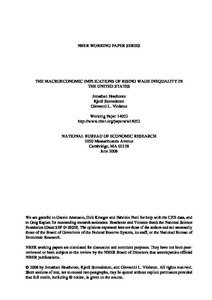The macroeconomic implications of rising wage inequality in the United States
"In recent decades, the US wage structure has been transformed by a rising college premium, a narrowing gender gap, and increasing persistent and transitory residual wage dispersion. This paper explores the implications of these changes for cross-sectional inequality in hours worked, earnings a...
| Main Authors: | , , , |
|---|---|
| Institution: | ETUI-European Trade Union Institute |
| Format: | TEXT |
| Language: | English |
| Published: |
Cambridge, MA
2008
NBER |
| Subjects: | |
| Online Access: | https://www.labourline.org/KENTIKA-19189296124919074789-The-macroeconomic-implications.htm |
| Summary: | "In recent decades, the US wage structure has been transformed by a rising college premium, a narrowing gender gap, and increasing persistent and transitory residual wage dispersion. This paper explores the implications of these changes for cross-sectional inequality in hours worked, earnings and consumption, and for welfare. The framework for the analysis is an incomplete-markets overlapping-generations model in which individuals choose education and form households, and households choose consumption and intra-family time allocation. An explicit production technology underlies equilibrium prices for labor inputs differentiated by gender and education. The model is parameterized using micro data from the PSID, the CPS and the CEX. With the changing wage structure as the only primitive force, the model can account for the key trends in cross-sectional US data. We also assess the role played by education, labor supply, and saving in providing insurance against shocks, and in exploiting opportunities presented by changes in the relative prices of different types of labor." |
|---|---|
| Physical Description: | 61 p. Digital |

